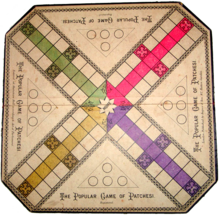Patchesi
The game Patchesi (or Homeward Bound ) is the first English Pachisi derivative and was created around the same time as the American Parcheesi . The term " Patchesi " is the English spelling of Pachisi. But it already has fundamental changes in the rules of the game and in the board.
history
Patchesi was marketed by John Jaques & Son, founded in 1795, from 1863 until the 1920s. The trademark of this game was only on March 4, 1864. There was an earlier patent in England from April 11, 1862 of a game called The Game of Puchese , but was never available on the market. The patent was issued to the unknown Messrs. Wood and Arathoon. It is not clear whether it was also the forerunner of the Patcheesi (later Parcheesi ) published four years later in the USA. It is possible that these games were both taken over from the Pachisi game at around the same time and were distributed in the different markets without being linked to one another. In contrast, the spelling Patcheesi (American) and Patchesi (English), as well as the designation of the center as "Home", are noticeably similar. Likewise, the same starting square on a safe square on the right hand lane of one arm and not in the middle as in the original Indian game is a remarkable coincidence if the American game did not evolve from the English one.
Game board
The board is very similar to the pachisi . The first noticeable difference is that Patchesi was made on cardboard and not on fabric, as is the case with the Indian original. The main differences for the game are the positions of the safe squares on the arms. Pachisi saw from the outside of the outer panels of each arm, and in the fourth position the safe fields. Patchesi , on the other hand, has the safe squares in the fifth position. This characteristic is the same as with Parcheesi and, as with the games resulting from these, Haste with Weile and Parchís . The color development of the middle trajectory of the arms is also an innovation compared to Pachisi and has not been retained in the successor games Ludo and Mensch ärgere Dich .
Rules of the game
- Each player places four pieces in the triangular fields of his color.
- Then the dice are rolled in turn until one player rolls a five. The first person to roll a five starts the game.
- It is pulled in a counterclockwise direction. To do this, you start on the safe field, which is on the path of your arm on the side of your own triangle. (As is the case, for example, with Parcheesi or Haste with a while .) You have to drag all left and right lanes of the arms until the pawn arrives on the arm of your own color. Then the pawn is drawn over the middle lane to the center ("Home").
- A pawn may only be removed from the corners and brought into play when the player rolls a five.
- If a six has been thrown, the player may throw the dice twice again and divide the individual throws among different pieces. If, however, a six was thrown each time in the two further throws, the player must put the pawn back on the triangular field that is closest to the target. The deferred pawn must be put back into play.
- When two playing figures of the same color come onto a field, they form a barrier. No tile (neither of the same or of a different color) can be drawn over these two. There may not be more than two pawns on the same space. Therefore, if a player's throw cannot be made, the throw becomes worthless.
- If a piece comes on the field of an opposing piece, it is captured and put back on the triangular field. A token on a space with a star cannot be captured.
- A piece cannot be moved over a piece of the same color.
- The first to draw all of his pieces into the center wins the game.
variants
Irving Finkel writes in his treatise on Pachisi that the first Patchesi game was played with three instead of four pieces. But this is a very rare variant that can also appear in the mother game Pachisi .
In the above rules of the game reference is made to a partner game and to a tournament game. This was also taken over from the original game Pachisi and modified.
literature
- Irving Finkel: Pachisi. In: Ulrich Schädler (ed.): Games of humanity. 5000 years of the cultural history of board games. (On the occasion of the 20th anniversary of the Swiss Game Museum (1987–2007)). Wissenschaftliche Buchgesellschaft, Darmstadt 2007, ISBN 978-3-89678-615-9 , pp. 83-92.


